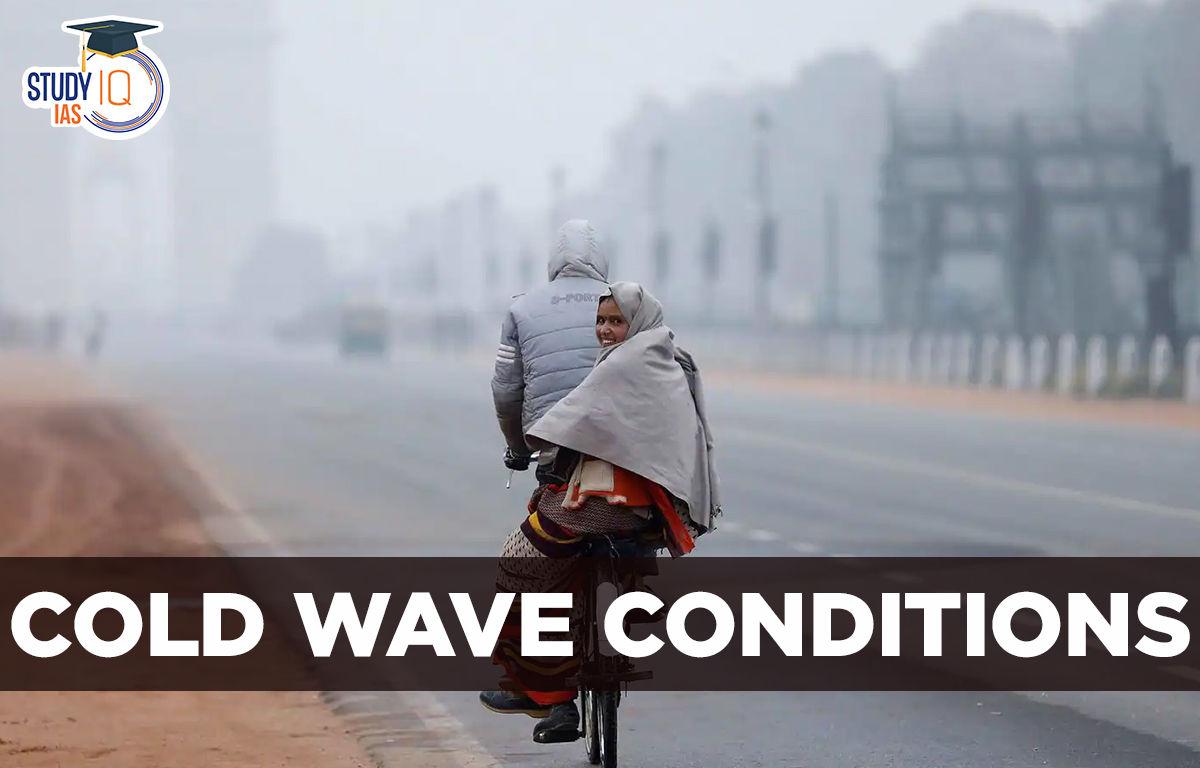Table of Contents
Context: The Indian Meteorological Department (IMD) has warned of severe cold waves in some parts of north Rajasthan and cold wave conditions in Haryana, Chandigarh, Delhi, and Punjab.
More on the Cold Wave Conditions in India
- Drop in temperatures: Several parts of Delhi recorded a temperature of 7 degree Celsius in the morning.
- The minimum temperatures in Delhi are likely to continue until January 1.
- Fog formation: Dense fog shrouded many parts of Punjab and Haryana due to intense cold weather conditions.
- The IMD also predicted very dense fog to continue over some parts of Uttarakhand, Punjab, Haryana, Chandigarh, and West Rajasthan over the next 24 hours due to prevailing light wind conditions and high moisture in lower tropospheric levels.
According to IMD
- “Very dense” fog is when visibility is between 0 and 50 meters.
- “Dense” fog is when visibility is between 51 and 200 meters.
- “Moderate” fog is when visibility is between 201 and 500 meters.
- “Shallow” fog is when visibility is between 501 and 1000 meters.
What is a Cold Wave?
- Meaning: A cold wave (or cold spell, cold snap) is a weather event involving a cooling of the air, or the invasion of very cold air, over a large area.
- Quantitatively, it is marked by a drop of average temperature well below the averages of a region.
- Qualitatively, cold wave is a condition of air temperature which becomes fatal to human body when exposed.
- Duration: Cold wave/Severe cold wave spells are of about 1-2 days, but in some cases spells last up to 10 days.
IMD Criteria for Cold Wave Causes
Cold Wave
When minimum temperature of a station <10° C for plains and <0°C for hilly regions.
- Based on departure
- Cold wave: Minimum temperature departure from normal -4.5°C to -6.4°C
- Severe cold wave: Minimum temperature departure from normal > -6.5°C
- Based on actual minimum temperature (for Plains only)
- Cold wave: When minimum temperature is < 4°C
- Severe cold wave: When minimum temperature is < 2°C
- For Coastal stations
- When minimum temperature departure is <-4.5°C or actual minimum temperature is < 15° C
Cold Day
When minimum temperature of a station <10° C for plains and <0°C for hilly regions.
- Based on Departure
- Cold day: Maximum temperature departure from normal -4.5°C to -6.4°C
- Severe cold day: Maximum temperature departure from normal > -6.5°C

Major Factors Responsible for Cold Wave Occurrence over India

Impacts of Cold Wave Conditions
- Impact Agriculture: Cold waves bring unexpected freeze and frost during the Rabi cropping season affecting crops, horticultural plantations/orchard, and other agricultural allied services.
- Impact on livestock: During a cold wave, the animals require a higher intake of nutrition. If the food is inadequate and there is exposure to low temperatures, animals may die of hypothermia or starvation.
- Impact on Health: The cold wave is extremely fatal to human health, and it could affect vulnerable people (infants, pregnant women, and elderly people) with chronic diseases.
- Impact on energy sector: The impact on the energy sector is well marked with a rise in the demand for fuels and electricity during cold wave conditions.
- Impact visibility: Fog formation associated with cold waves can affect visibility, which can cause more accidents, including fatalities.
- Impact on infrastructure: For instance, specific plumbing is required in colder regions. Similarly, antifreeze needs to be added to the car for it to function.


 AI Maker Labs: A Promise to build AI in ...
AI Maker Labs: A Promise to build AI in ...
 Daily Quiz 15 April 2025
Daily Quiz 15 April 2025
 How RBI Responded To Global Trade War Ch...
How RBI Responded To Global Trade War Ch...





















